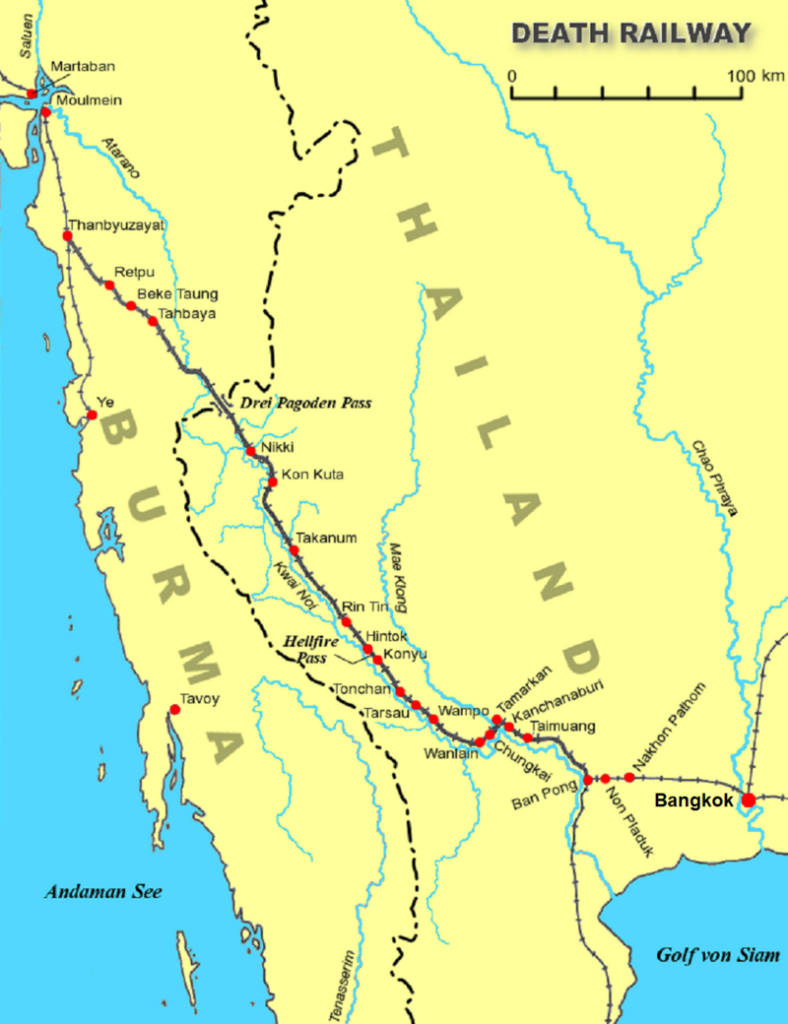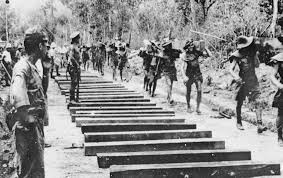Updated 12/03/2025
In the story of the (Nazi) Murder factories, the Nazi concentration camps, the Einsatzgrüppen, Sonderkommandos, the ghettos and the death marches have been discussed extensively.
The incredible amount of suffering the victims faced is actually incomprehensible.
All thanks to the efforts of SS men Heinrich Himmler, Reinhart Heydrich and later his successor Ernst Kaltenbrunner.
That the inhabitants of the places around the concentration camps would have known nothing is almost impossible. The stench of the crematoria and the smelly mass graves alone can no one who lived in the immediate vicinity have escaped.
The story of the Murder factories is the drama that has taken place in Europe. What about the behavior of the Japanese on the other side of the globe?
Well, it wasn’t much different there. The Japanese did not concentrate on the Jewish population, that was not an item for them. There were several internment camps. Some camps were for prisoners of war only, some camps were specific to civilians and the third category was a mix of both. As for the prisoners of war, the Japanese had a separate view on the soldiers in the camps. In the experience of the Japanese, surrender in the battle was not an option. They continued to the bitter end, in the name of the Japanese emperor. Prisoners of war were therefore considered cowards with whom the Japanese did not want to have any compassion and were also treated as such. Torture, starving, degrading punishments after a minuscule offence, it was the order of the day and the Japanese who were involved with this showed no compassion whatsoever with the prisoners.
The most famous Japanese internment camps:
Cabanatuan, Capas, Los Banos, Santo Tomas at Manila, Puerto Princesa, John Hay at Baguio, Holmes, Manganese, Guindulman, Bohol and the New Billibid Prison prison at Muntinlupa.
The Lost Battle of Bataan

At the same time as the attack on Pearl Harbor, the naval units on Taiwan and in Cavite in the Philippines were also attacked. Major U.S. Air Force bases Clark Field, Iba Field and Nicholas Field were attacked.
From December 8 to 10, the combination of American and Filipino troops tried to reverse the difficult situation but could not prevent the Japanese from landing on Batan Island, Aparri and Vigan City. The actual offensive on December 22 of the Japanese Imperial Army led by Masaharu Homma marked the end of the Far East Air Force. The Philippines was taken and the Japanese captured two airports to support the next step, the takeover of the Dutch East Indies. At the Battle of Bataan, the Americans and the Filipinos capitulated. For the Americans the most important capitulation since the American Revolution.
79,000 Allied soldiers, 67,000 from the Philippines, 12,000 Americans surrendered to the Japanese army. The Japanese wanted to remove the prisoners of war from Bataan as soon as possible, but were prepared for 25,000 prisoners and did not plan to transport the large group in a humane way.
The route started at the southern tip of Bataan. Due to the poor conditions, all kinds of infectious diseases quickly broke out. First 88 kilometers had to be walked to San Fernando, then a train trip to Capas and then walk 13 kilometers to the final destination, Camp O’Donnell. Thousands of men died along the way from the effects of diseases, starvation, dehydration, sunstroke, untreated wounds or by executions. Anyone who found water or food and ate or drank it in front of the guards was abused or killed directly. The prisoners who had fallen and other laggards were shot dead by Japanese death squads. Once in the camp, the prisoners bivouaced between the corpses of the dead. It is estimated that during the death march 5,000 to 10,000 Filipinos and 650 Americans were killed.
On June 6, 1942, the Philippine soldiers were released, but the Americans remained detained. Over time, they were transferred to Cabanatuan and then transported by ship to camps in Japan, Korea and Manchuria. In January 1945, the last 511 remaining prisoners of war at Cabanatuan were liberated by a special action by the U.S. Army (The Great Raid).
The Kempeitai

The Kempeitai was in fact the Japanese version of the German Gestapo. And they were not inferior to Hitler’s most feared SS men. The chief of the Kempeitai was only accountable to the Ministry of War. As a result, there was virtually no control over the activities of the Kempeitai. The Kempeitai’s goals were:
Engaging the economic potential of the occupied territory for Japanese warfare
Insulate foreigners such as English, Americans and Australians
Ensuring that the conquered territories accept Japanese supremacy and defuse opponents
Preventing help from outside the conquered territories
The legal proceeding
When an arrestee was found guilty, a judgment of the military court followed. The “evidence” often consisted of extorted confessions. In the death penalty, the execution was often carried out on the ground without trial. What acts of terrorism were committed to enforcing confessions?
The frequent beating of the prisoner with all kinds of materials; whips, sticks, iron rods
Long-lasting kicking the body everywhere with heavy shoes
Throw in the air and then drop
Burn all kinds of materials against the body
For a long time in the sun, kneeling with a flowerpot on the head
Pour large amounts of water into the mouth and then kick on the stomach
Lower the head down into a well
Puting hands in boiling water
The use of electricity on very sensitive parts of the body
Hanging by wrist bound behind the back
To pierce the eardrums with pencils
Taking off the nails
Starving
Treating open wounds with salt
And much more……
Conversations with fellow prisoners in the camps or in prison were not possible. Only by sticking your head in the open sewer could you still communicate somewhat. The sewer then worked like a phone. If you were caught, the unfortunate one had to eat the sewer content.
War crimes
The number of war crimes committed by the Japanese is enormous. In 1937 and 1938, before the Second World War, the Nanking Massacre took place. Although the numbers differ again at the various sources, between 260,000 and 350,000 civilians and prisoners of war were killed.
From 1942, the new policy was introduced under the motto “kill everything, burn everything and plunder everything”. 2.7 million civilians died because of this policy.
For example, in the Manilla massacre, 100,000 civilians were murdered in the Philippines, in the Sook Ching massacre in Singapore between 50,000 and 90,000 victims, especially of Chinese descent, the Parit Sulong massacre in Malaysia, the Changjiao massacre, the Laha massacre in Indonesia, the massacre of Kalagon and Pontianek, the number of deaths was unimaginable. During the occupation of British Borneo, thousands of native civilians were killed.
At the same time, biological warfare took place and experiments on humans (Unit 731), chemical weapons were used by the Japanese Air Force, especially poison gas. The Japanese Navy sank many ships and killed people in the lifeboats.
The Burma-Siam Railway

A railway line had to be constructed between Non Pladuk in Thailand (Siam) and Thanbuyuzayat in Burma (Myanmar). The line was supposed to facilitate the supply of Japanese troops and material to the Burmese front. The railway was to be built by the prisoners of war. The prisoners of war were divided into groups to work on a certain trajectory. Each forced labourer had to move one cubic meter of land a day and be proud of the fact that he was allowed to work for the Japanese emperor Hirohito.
Each process involved a labor camp. The labor camp was hit by the poor conditions by malaria and dysentery. Sick or not, work had to be done. Due to the dysentery, the forced labourers suffered from severe dehydration and the number of victims increased steadily.
In the summer of 1943, according to the Japanese, the work did not go fast enough. With the help of Asian workers, who had been lured under false pretenses, production had to be stepped up. With their arrival, all hell in the camp broke loose. Cholera broke out and could not be stopped. Doctors and medicine were not or hardly available and the majority of the workers died along the railway.
On 7 October 1943, the Burma-Siam railway was finished and had become 415 km long. The prisoners of war now had to carry out maintenance on the railways and build barracks.

In 1944, the Allies began bombing the railway line and bridge over the Khwae Yai River. The bombs also caused death and destruction in the camps. The Allies were not aware of the presence of the prisoners of war.
It is estimated that between 80,000 and 100,000 prisoners of war have been killed in the construction of the railway. The railway was later called the “death railway”. Some of it is still in use today. The route runs from Non Pladuk to Nam Tok. The other parts have become overgrown.
In addition to the work on the Burma-Siam Railway, forced labourers were also deployed at the Pakanbaroe Railway between Pekanbaroe and Muaro on Central Sumatra and for the construction of airports on Flores, on the Moluccans and in the mines or other industries in Japan.
Unit 731, Japan’s Disturbing Human Experiments Program
The story of the attack on Pearl Harbor reports on the abuse of the citizens of Quzhou by Unit 731 at the end. The content of that story can certainly be added to the above crimes against humanity. Japan was very good at this in World War II, perhaps even better than Heinrich Himmler and his friends.
Source:
War stories.com
Wikipedia – Kempeitai
Wikipedia – The Battle of Bataan, Japanese War Crimes